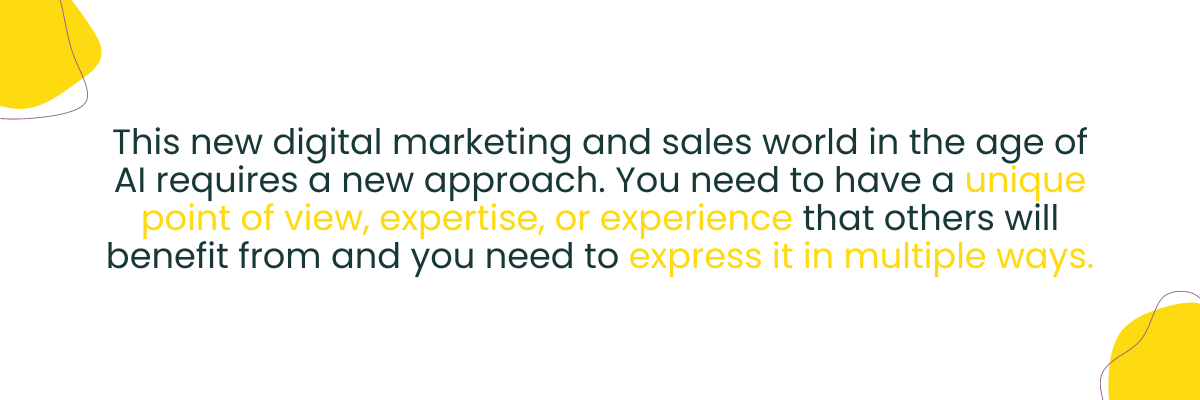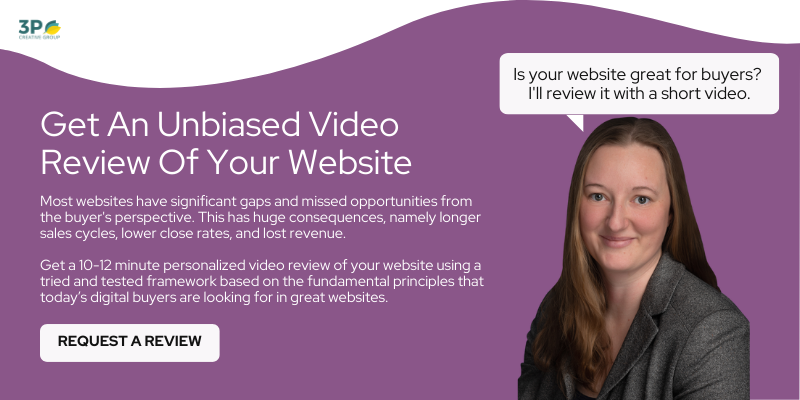Inbound Marketing Is Dead. What This Means For Your Marketing Strategy
Are you frustrated by the lack of leads coming through your inbound marketing efforts these days? If so, you are not alone. For the last two years or so, inbound marketing has become less and less effective. This is, of course, more true for some industries (e.g., marketing agencies) than for others. But overall, there is a significant decline.
Over the last thirteen years, I have seen digital marketing and sales drastically change. This change was drastically accelerated by the adoption of generative AI and the content floodgates it opened. Lured by the promise of easy organic search traffic by generating hundreds of articles in a span of hours, many tried to trick the system and utilize AI to their advantage. But does it work?
In this article, I will explain why the old way (content-driven inbound marketing) isn't effective as a stand-alone method anymore and why you need to take your content creation and lead generation off auto-pilot and start really digging into your expertise and experience. By the end of the article, you will know exactly how to tackle your marketing (and sales, but I will get to that) from now on.
Content-Driven Inbound Marketing With The Goal Of Lead Generation Isn't Working Anymore
Ah, the good old days. I remember when Inbound Marketing first began, I loved that lead generation was like a math problem to be solved. If you wanted a certain number of new customers, you could calculate your conversion rates and estimate how much traffic your website needed to generate enough leads. All you had to do was to:
- Create a steady flow of blog articles,
- Optimize them for SEO and publish them on your blog,
- Get ranked high on search engine result pages,
- Promote them a little on social media to help distribution,
- Put a call to action below to point readers to eBooks, whitepapers, or other mostly text-based lead generation offers, and
- Nurture them with an email sequence until they are ready to buy.
It was so easy and straightforward that everyone started to create content.
Inbound Marketing Success Leads To A Content And Channel Explosion
Within a few years, some industries were so flooded with generic blog articles that it got much harder to rank. Organic search traffic declined. You needed to target long-tail keywords, niche down, and get much more specific with your content. So everyone did that, rinse and repeat: Things were easy, and now everyone is doing it, so it got much harder.
At the same time, new channels emerged to help distribute and promote content, such as online publishing platforms (e.g., Medium, Tumblr, and SubStack) and content distribution platforms (e.g., Outbrain, Buffer, and Slideshare). New social media platforms emerged (e.g., TikToc, Threads, and Snapchat), and existing ones expanded their functionality (e.g., LinkedIn newsletters, YouTube Shorts, and Spotify Podcasts). The list goes on and on.
The Result: A Quicksand Of Random Acts Of Marketing
Every one of these new channels has slightly different requirements. Each channel requires a slightly different format or type of content, a different style of writing as well as images and video formats that suit that particular channel. On the flip side, some types of content are more suited for some channels than others.
Now you end up producing dozens of pieces of content: long-form blog articles, webinar recordings, podcast episodes, LinkedIn newsletters, email newsletters, LinkedIn posts for your company page and personal profiles, short-form videos for Instagram reels, TikTocs, and YouTube Shorts, … you get the point. But they all feel random just to satisfy the need to create content.
Unless you are extremely organized, this almost instantly results in random acts of marketing that act like quicksand sucking all creativity and fun out of your marketing. The result: frazzled marketers wearing way too many hats trying to keep up. Quality suffers and trust built over years is lost.
AI-Powered Content To Educate Your Customer & Build Trust
With the advancements in Artificial Intelligence (AI), marketers can ideate, create, improve, edit, and personalize content much faster and at a much larger scale. For many, this is an amazing way to accelerate content production. However, simply using AI to accelerate your inbound marketing as described might result in some short-term results (we all heard the stories of someone using AI to write hundreds of AI articles and get more traffic), but this is unlikely to last.
Because here is the thing: it is easier than ever to generate content using generative AI. However, generative AI reads what is on the web (already available content) and regurgitates it. So the value of content is zero if simply applied to the old way of content-driven Inbound Marketing.
This new digital marketing and sales world in the age of AI requires a new approach. You need to have a unique point of view, expertise, or experience that others will benefit from and you need to express it in multiple ways, e.g., video, social posts, articles, podcasts, and even new formats, e.g., voice narration for long-form articles to make them more accessible.

Just as before, this results in a huge number of assets in diverse content formats and for different channels. However, instead of creating content to rank for keywords or to generate leads, the goal is to educate your buyers across the entire customer journey and to build trust and long-lasting relationships.
The difference here is that we are using AI to free us up to produce more thoughtful content that truly reflects our unique expertise and experience or express a unique opinion or point of view. AI also allows us to create better customer experiences by making it easier to personalize content at scale.
AI Makes It Easy To Repurpose Content In Different Formats
AI technology has made it easier than ever to create content in various formats. From generating scripts for videos and podcasts to creating engaging graphics for social media, AI tools allow marketers to experiment with different types of content without the need for extensive resources or specialized skills. This versatility is key to reaching audiences across multiple platforms and keeping them engaged with fresh, innovative content.
Example: TrustBuilder Podcast
Let me illustrate this on my podcast, TrustBuilder. Each episode is an expert interview that is about 38 to 45 minutes long. For each episode, I routinely now create the following:
- 1 audio-only episode that lives on different podcast hosting platforms,
- 1 video episode that lives on YouTube,
- 3-5 short video clips for social media,
- 1 LinkedIn newsletter that has gained 177 subscribers in just 6 weeks, and
- 1-2 LinkedIn posts for my personal LinkedIn account.
I could also publish a blog post with the transcript alongside the episode and a speaker bio, as many other podcasters do. In addition to the above, in this 45-minute expert interview, I have gathered enough insights to dive deeper and create:
- 3 or 4 additional blog articles to further explore some interesting insights,
- 1 or 2 editorial-type email newsletters to showcase some unexpected findings,
- 8-10 social media posts (including a LinkedIn carousel) highlighting some surprising point the expert made or a thought you would like to talk about more.
This is a huge opportunity, not to mention the priceless opportunity to build relationships with experts in your field. The ultimate goal of the new content strategy is not just to generate leads but to build your tribe and community. Over time, this community becomes more than just passive consumers; they become advocates for the brand, contributing to its growth and success.
Conclusion
In summary, writing keyword-targeting generic blog articles for organic traffic and lead generation is no longer as effective. While AI can immensely accelerate content creation and repurposing, brands need to focus on having a unique point of view or educating their buyers with their expertise and experience. These POVs will be distributed in a much greater variety of formats and in many more channels than ever before.
If this resonates with you but you are still not sure or you have additional questions, I am happy to chat. I am offering a free 60-minute coaching session to my readers in the hopes of helping work through this transition. Don't believe it? Try it and schedule yours today.
Share this
You May Also Like
These Related Stories
![Marketing Agency vs. In-House Marketing + Coaching [A Side-By-Side Cost Comparison]](https://blog.3pcreativegroup.com/hubfs/Marketing%20Agency%20vs.%20In-House%20Marketing%20+%20Coaching%20%5BA%20Side-By-Side%20Cost%20Comparison%5D.png)
How Much Does It Cost To Hire A Marketing Agency vs. Doing Your Own Marketing (Incl. Coaching)?

How To Measure Your Inbound Marketing ROI

.png?width=250&height=125&name=TrustBuilderLogoWhiteTranspBackgr(250x125%20px).png)


No Comments Yet
Let us know what you think